【优质】小学英语沪教版六年级下册Unit 10《Great storybooks》优质公开课教案第一课时
- 格式:doc
- 大小:331.00 KB
- 文档页数:7
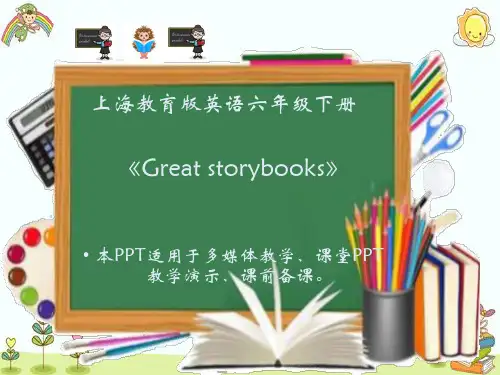
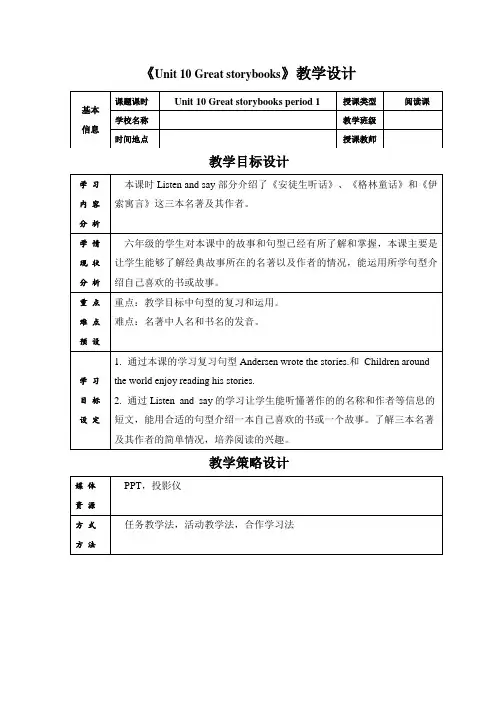
《Unit 10 Great storybooks》教学设计教学目标设计教学策略设计学习评价设计【主要内容】1. Check students ‘homework: read the name of the books and match the stories with the books.【评价反馈】小组评价【主要内容】1. Read and answer. The teacher asks students to read paragraph 1 and 2, and then answer the questions.2. Read and retell. Ask students to find the key words in Para 3 and 4, and then retell the test with your own words.3. Do a survey. Ask students to do a survey about the classmate’s favorite story and make a report.【评价反馈】1.教师评价2.学生评价【主要内容】1. Find some Chinese classical books and share to our classmate.2. Make a reading card about your favorite Chinese stories.【评价反馈】1.组长评价2.教师评价教学过程设计【激趣导入】 1.The teacher shows some pictures about students reading books in ourschool.2. Ask the question “What is he thinking about?” “Do you like reading?”“What kind of books does you like reading?”【设计意图】1.通过图片引出本课主题。
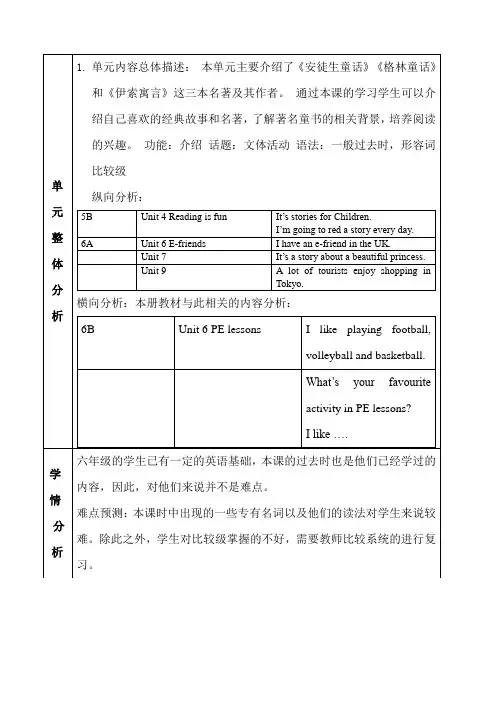
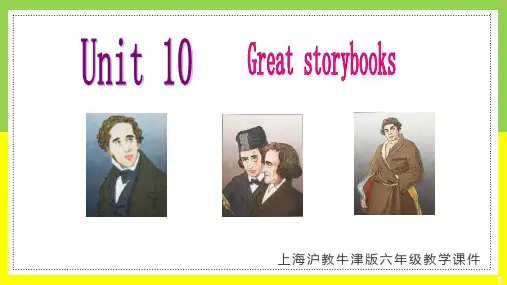
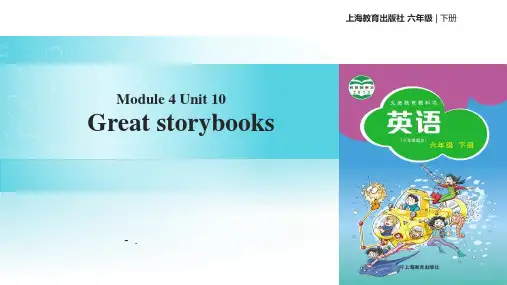
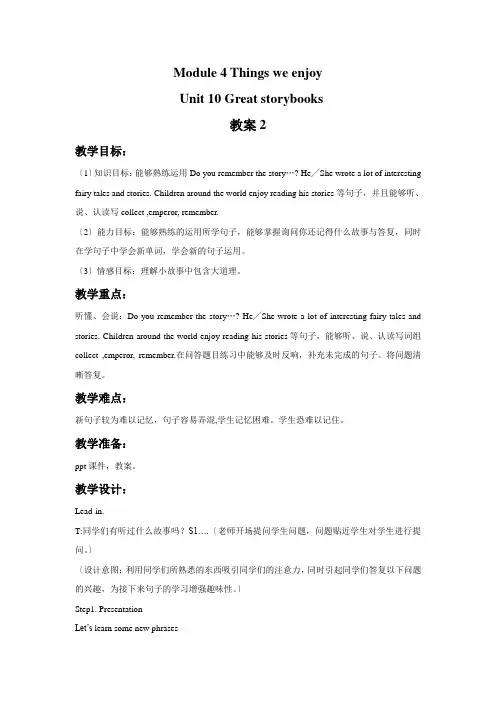
Module 4 Things we enjoyUnit 10 Great storybooks教案2教学目标:〔1〕知识目标:能够熟练运用Do you remember the story…? He╱She wrote a lot of interesting fairy tales and stories. Children around the world enjoy reading his stories等句子,并且能够听、说、认读写collect ,emperor, remember.〔2〕能力目标:能够熟练的运用所学句子,能够掌握询问你还记得什么故事与答复,同时在学句子中学会新单词,学会新的句子运用。
〔3〕情感目标:理解小故事中包含大道理。
教学重点:听懂、会说:Do you remember the story…? He╱She wrote a lot of interesting fairy tales and stories. Children around the world enjoy reading his stories等句子,能够听、说、认读写词组collect ,emperor, remember.在问答题目练习中能够及时反响,补充未完成的句子。
将问题清晰答复。
教学难点:新句子较为难以记忆,句子容易弄混,学生记忆困难。
学生恐难以记住。
教学准备:ppt课件,教案。
教学设计:Lead-in.T:同学们有听过什么故事吗?S1….〔老师开场提问学生问题,问题贴近学生对学生进行提问。
〕〔设计意图:利用同学们所熟悉的东西吸引同学们的注意力,同时引起同学们答复以下问题的兴趣,为接下来句子的学习增强趣味性。
〕Step1. PresentationLet’s learn some new phrases简单的用图文并展的方式首先将新单词引入,教同学识读单词collect ,emperor, remember 〔设计意图:直接的语音教学让学生牢记单词发音,为接下来句子的运用打下根底。
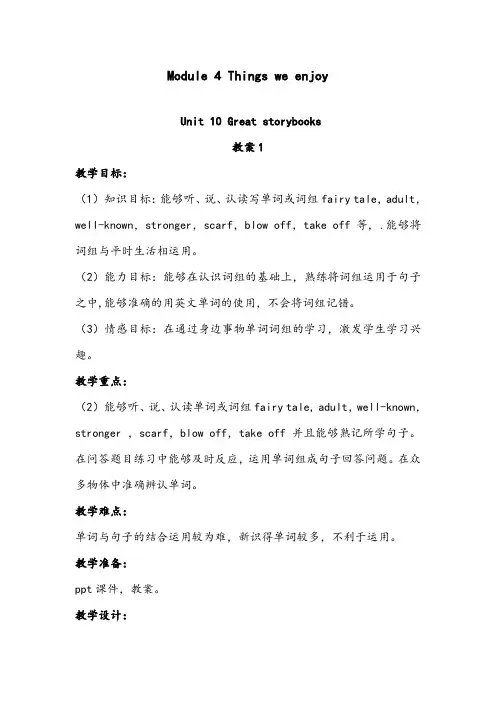
Module 4 Things we enjoyUnit 10 Great storybooks教案1教学目标:(1)知识目标:能够听、说、认读写单词或词组fairy tale,adult,well-known,stronger,scarf,blow off,take off等, .能够将词组与平时生活相运用。
(2)能力目标:能够在认识词组的基础上,熟练将词组运用于句子之中,能够准确的用英文单词的使用,不会将词组记错。
(3)情感目标:在通过身边事物单词词组的学习,激发学生学习兴趣。
教学重点:(2)能够听、说、认读单词或词组fairy tale, adult,well-known,stronger ,scarf,blow off,take off并且能够熟记所学句子。
在问答题目练习中能够及时反应,运用单词组成句子回答问题。
在众多物体中准确辨认单词。
教学难点:单词与句子的结合运用较为难,新识得单词较多,不利于运用。
教学准备:ppt课件,教案。
教学设计:Step1. PreparationLead-in.T:同学们,你们觉得今天我们会学什么?S1:….(老师开场提问学生问题)(设计意图:通过提出问题让学生独立思考发现问题答案。
培养学生的想象力,提高学生的注意力。
)Step2. PresentationLet’s get to learn some new phrases.教师展示新学词组的图片(fairy tale,adult,well-known,stronger,scarf,blow off,take off),同时配上单词及意思,让同学跟随老师大声学读单词,同时将图片与相对应单词相熟悉对应。
在将单词与句型相结合起来,不断操练单词的熟悉度。
(设计意图:通过简单直接的图片展示能够让同学们更好的了解事物,了解单词的意思,此时学生在脑中有一个直观的映像,对各种活动词组有一个更加直接明了理解,能够让同学们能够在理解的基础上记忆,重复朗读单词可以练习学生的发音,避免哑巴英语教学。
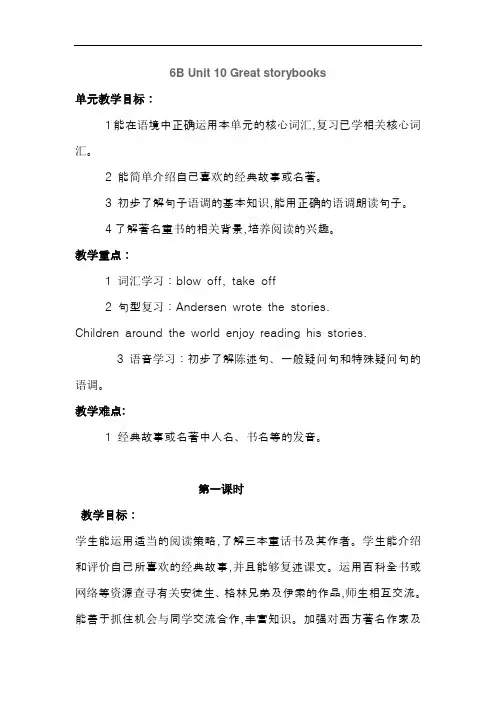
6B Unit 10 Great storybooks单元教学目标:1能在语境中正确运用本单元的核心词汇,复习已学相关核心词汇。
2 能简单介绍自己喜欢的经典故事或名著。
3 初步了解句子语调的基本知识,能用正确的语调朗读句子。
4了解著名童书的相关背景,培养阅读的兴趣。
教学重点:1 词汇学习:blow off, take off2 句型复习:Andersen wrote the stories.Children around the world enjoy reading his stories.3 语音学习:初步了解陈述句、一般疑问句和特殊疑问句的语调。
教学难点:1 经典故事或名著中人名、书名等的发音。
第一课时教学目标:学生能运用适当的阅读策略,了解三本童话书及其作者。
学生能介绍和评价自己所喜欢的经典故事,并且能够复述课文。
运用百科全书或网络等资源查寻有关安徒生、格林兄弟及伊索的作品,师生相互交流。
能善于抓住机会与同学交流合作,丰富知识。
加强对西方著名作家及其文学作品的了解。
通过本课的学习,引导、教育学生要多读书、读好书。
通过读书吸收前人的智慧,不断丰富学识和提高自身素质。
教学重难点:句型复习:Andersen wrote the stories. Children around the world enjoy reading his stories.教学方法与手段:本节课我采用导学自悟法,对话法进行教学。
采用PPT课件,卡片,录音机作为教学辅助手段。
使用教材构想:本节课学生在对课文进行整理,理解基础上,构建思维导图,并根据思维导图进行问答,介绍自己喜欢的作品。
教学方法和过程:Pre-task preparations1 用图片的形式展示一些童书的封面,让形式试着说说这些书名,中英文均可。
同时出示这几个作者的照片。
T:(show the covers of the books)Look at these books. Did y ou read them?S1:Yes, I did. It’s Andersen’s Fairy Tales...T:(show some pictures of the writers)Do you know who wtote these books? These are the writes. Who is he?S2:He’s Andersen.学生尝试将人物图片和书配对。
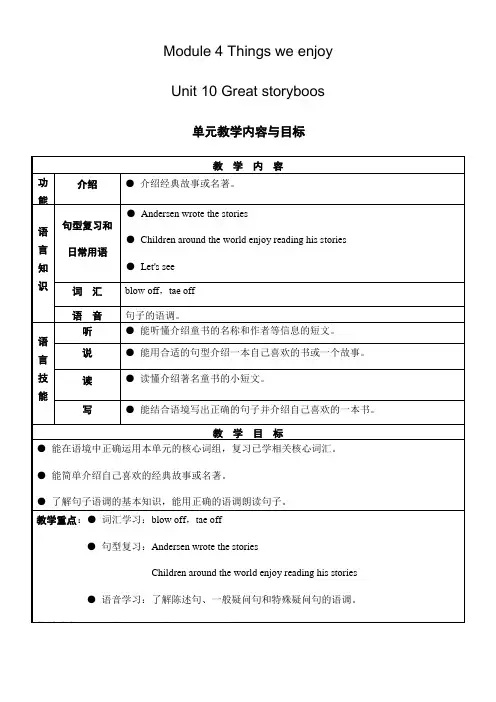
Module 4 Things we enjoy Unit 10 Great storyboos 单元教学内容与目标分课时教学目标一、任务预设学生能够简单描述自己喜欢的书,包括书的名称、作者姓名、书的大意等,制作一幅读书周的海报。
二、课时分配第二课时ething about the writer Aesoany fables about animals There are some well-nown fables lie“The fo and the gra Aeso Aeso an3)What did Mr Sun and Mr Wind do They had a race4)What did the man do when Mr Wind blew He an do when Mr Sun shone He too off his coat6)Who was stronger,Mr Wind or Mr Sun Mr Sun学生观看完或听完故事后,尝试回答以上问题。
2 根据学生的回答,在黑板上呈现故事概要,学生理解故事大意。
板书如下:尝试让学生根据板书概述故事的大意,可以通过小组或个人的方式完成。
S1: One day,Mr Wind and Mr Sun had a race They wanted to see who was stronger They saw a man Mr Wind blew strongly The man felt cold,so he an The man felt hot and too off his coat So Mr Sun won the race He was stronger3 把学生分成四人一组准备表演课本剧。
在表演前先让学生在组内决定个人承担的角色。
T:Now let's act out the story First,tell me how many characters there are in the storyS1:FourT:Who are theyS2:They're the man,Mr Wind,Mr Sun and the narratorT:Yes,the storyS1:Being ean you are strongT:Sometimes indness also maes us strong,right家庭作业:1 Listen to and read Student’s Boo pages 64 and 652 Retell the story on Student’s Boo pages 64 and 653 Finish Worboo pages 57 and 59板书设计:Unit 10 Great storyboos 第二课时。
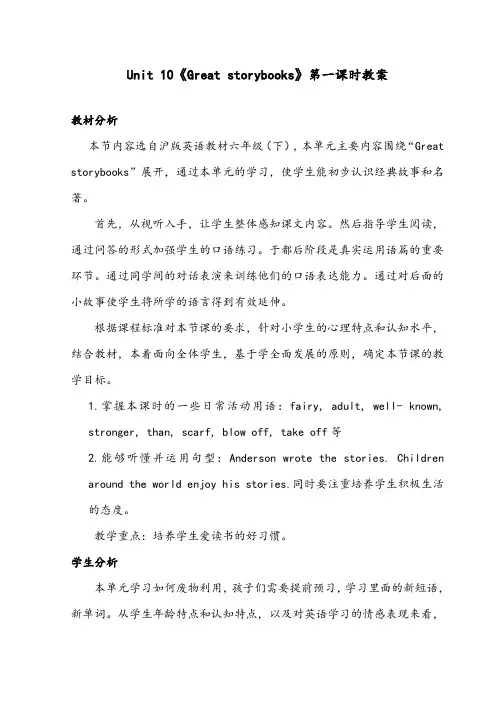
Unit 10《Great storybooks》第一课时教案教材分析本节内容选自沪版英语教材六年级(下),本单元主要内容围绕“Great storybooks”展开,通过本单元的学习,使学生能初步认识经典故事和名著。
首先,从视听入手,让学生整体感知课文内容。
然后指导学生阅读,通过问答的形式加强学生的口语练习。
于都后阶段是真实运用语篇的重要环节。
通过同学间的对话表演来训练他们的口语表达能力。
通过对后面的小故事使学生将所学的语言得到有效延伸。
根据课程标准对本节课的要求,针对小学生的心理特点和认知水平,结合教材,本着面向全体学生,基于学全面发展的原则,确定本节课的教学目标。
1.掌握本课时的一些日常活动用语:fairy, adult, well- known,stronger, than, scarf, blow off, take off等2.能够听懂并运用句型:Anderson wrote the stories. Childrenaround the world enjoy his stories.同时要注重培养学生积极生活的态度。
教学重点:培养学生爱读书的好习惯。
学生分析本单元学习如何废物利用,孩子们需要提前预习,学习里面的新短语,新单词。
从学生年龄特点和认知特点,以及对英语学习的情感表现来看,本单元的教学对象是小学六年级的学生,他们学习英语的热情虽然没有低年级学生那么高、兴趣也没那么浓,但他们喜新好奇,求知欲强,富有想象力,并且具有较高的表现欲,且经过几年的英语学习,他们已有一定的词汇和语言基础。
而且他们也有比较强的竞争意识,尤其是我所教的班级,更是喜欢小组竞赛和个人竞赛以及各种表演,更喜欢通过活动游戏等形式学习新知。
教学目标Knowledge objectives知识与技能1.掌握本课时的一些日常活动用语:fairy, adult, well- known,stronger, than, scarf, blow off, take off等2.能够听懂并运用句型:Anderson wrote the stories. Childrenaround the world enjoy his stories.同时要注重培养学生积极生活的态度。
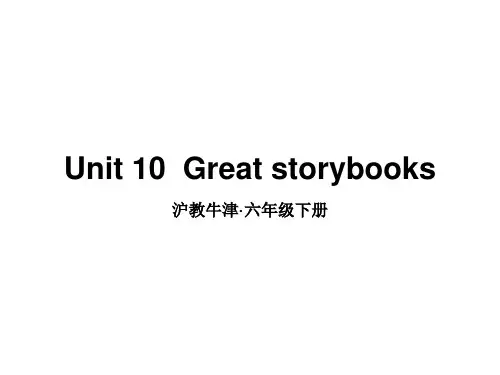
牛津上海版深圳用6B Unit10 Great storybooks 单元练习一.语音判断判断下列各组划线部分的发音,相同的写A, 不同的写B。
( ) 1. A. sk a ting B. d a nce C. a bout ( ) 2. A. t i ger B. favour i te C. l i ve ( ) 3. A. th e se B. str ee t C. r e member ( ) 4. A. c o ld B. p o st C. o kay ( ) 5. A. c u te B. u se C. s u nny二.选择填空从每小题的三个选项中选出最佳选项。
( ) 1. Children around the world enjoy ______the great storybooks.A.readB. readingC. looking( ) 2. John____out of the window and _____his parents there.A.saw,lookedB. looks,seesC. looked,saw( ) 3. What’s your _______story?A. likeB. the bestC. favourite( ) 4. Sam, let’s go and see a film. It’s about food in China._______.A. Don’t worry.B. That’s right.C. Good idea. ( ) 5. Jane was very happy because she ______a papercutting yesterday all by herself.A. madeB. makesC. making三.完形填空从短文后每小题的三个选项中选出能填入相应空白处的最佳选项。
There is __1___ti ger and a fox in the forest. The tiger is the king of the forest.One day, he is very hungry, so he looks __2__(寻找)food. He sees the fox.Soon he catches the __3__. The fox is very afraid. But the fox has a goodidea. He says, "I am the king of the forest. You __4__ eat me. Follow meand you'll see." The tiger follows the fox into the forest. When the littleanimals see the tiger __5___the fox, they run away. So the tiger thinksthe animals are afraid of the fox, and he is afraid too. He sets the foxfree(放了狐狸)。
Unit 10《Great storybooks》第一课时教案
教材分析
本节内容选自沪版英语教材六年级(下),本单元主要内容围绕“Great storybooks”展开,通过本单元的学习,使学生能初步认识经典故事和名著。
首先,从视听入手,让学生整体感知课文内容。
然后指导学生阅读,通过问答的形式加强学生的口语练习。
于都后阶段是真实运用语篇的重要环节。
通过同学间的对话表演来训练他们的口语表达能力。
通过对后面的小故事使学生将所学的语言得到有效延伸。
根据课程标准对本节课的要求,针对小学生的心理特点和认知水平,结合教材,本着面向全体学生,基于学全面发展的原则,确定本节课的教学目标。
1.掌握本课时的一些日常活动用语:fairy, adult, well- known,
stronger, than, scarf, blow off, take off等
2.能够听懂并运用句型:Anderson wrote the stories. Children
around the world enjoy his stories.同时要注重培养学生积极生活的态度。
教学重点:培养学生爱读书的好习惯。
学生分析
本单元学习如何废物利用,孩子们需要提前预习,学习里面的新短语,新单词。
从学生年龄特点和认知特点,以及对英语学习的情感表现来看,
本单元的教学对象是小学六年级的学生,他们学习英语的热情虽然没有低年级学生那么高、兴趣也没那么浓,但他们喜新好奇,求知欲强,富有想象力,并且具有较高的表现欲,且经过几年的英语学习,他们已有一定的词汇和语言基础。
而且他们也有比较强的竞争意识,尤其是我所教的班级,更是喜欢小组竞赛和个人竞赛以及各种表演,更喜欢通过活动游戏等形式学习新知。
教学目标
Knowledge objectives
知识与技能
1.掌握本课时的一些日常活动用语:fairy, adult, well- known,
stronger, than, scarf, blow off, take off等
2.能够听懂并运用句型:Anderson wrote the stories. Children
around the world enjoy his stories.同时要注重培养学生积极生活的态度。
过程与方法
主要从激发和保持学生的学习兴趣入手,注重培养和激发学生的积极性和自信心,让学生在教师的指导下通过感知和体验、实践、参与和合作等方式实现任务的目标,感受成功。
情感态度和价值观
1.培养学生对生活的热爱、爱学习,爱学习的好习惯。
2.帮助学生拓展知识面,增强安全意识。
重点难点
教学重点、难点
1.句型与短语相结合在实际情景中的具体运用。
2.能够听懂并运用句型:Anderson wrote the stories. Children
around the world enjoy his stories.同时要注重培养学生积极生活的态度。
教学方法
教法
直观教学法、游戏教学法和任务型教学法。
通过这些方法让学生自主地参与到课堂教学的活动中来,并在活动中得到认识和体验,使学生体会到生活的美好和保护环境的重要性,学会循环利用废旧物品。
学法
从学生的学习兴趣,生活经验和认识水平出发,倡导体验、时间、参与、合作与交流的学习方式和任务型教学途径达到发展学生对语言的综合运用能力。
这个过程要注重师生互动,从游戏、对话等活动完成本课学习
课时安排
1课时
课前准备
教师准备
录音机、磁带、单词卡片,视频文件等。
学生准备
1.阅读预习教材;
2.完成导学。
教学过程—第一课时
Teaching Procedures
Step1 Warming up
1. Greeting
2. Freetalking
T: Do you like reading stories?
Ss: Yes.
T: What’s your favourite stoty?
Ss: My favourite story is ……
T: Very good! Today we’ll learn three great storybooks.
3. 教师板书 Unit 10 《Great storybooks》
Step2 presentation 呈现
1.Listen and say. Page – 62
2.首先听录音,使学生对课文有个概况了解。
有些看来是废品的东西
还是可以再次被利用的
Show the covers of the books.\
Show some pictures of the writers.
3.Listen and say
Teach your little students and read again.
4.Show the name of some stories. Page – 63
T: Here are some stories. Did you read any of the stories
before?
S: Yes, I read “Cinderella”.
T: Do you know who wrote these stories?
S: No!
T: Today, we’re going to find out who wrote these stories? Step 3 Learn the sounds
Listen and say
1)Are these pens yours? Yes, they are.
2)Did you play basketball yesterday? No, I didn’t.
3)Where do you live? I live on May Street.
Step 4 practice and consolidation 巩固练习
Think and write
What stories did you read? Write about a story you like.
Step5 Listen to the tape again
加强听力练习
Step6 homework and everyday English
1. Homework::Collect some other stories of great storybooks。
2. Everyday English: Keep your face to the sunshine, and you
cannot see a shadow.
------ 面朝大海,你的世界就无阴影。
板书:
Unit 10 Great storybooks
Aesop’s Fables: The wind and the sun
The fox and the grapes
The farmer and the snake
Anderson’s Fairy Tales:
The emperor’s new clothes
The ugly duckling
Grimms’ Fairy Tales:
Little Red Riding Hood
Cinderella
Snow White
教学反思
通过本课的学习,让学生多了解一些世界著名的童话故事,多读书对我们的学习有非常大的好处,了解古今中外,涌现出许多杰出的科学家,他们充满智慧、博学多闻、证实观点的故事,使学生了解到知识、尝到乐趣、获得知识,培养出科学人文精神相容合的创新型人才。